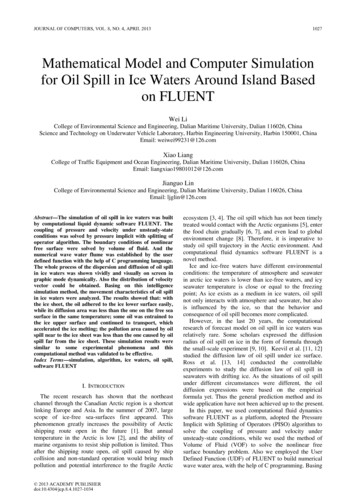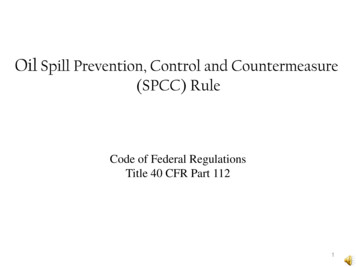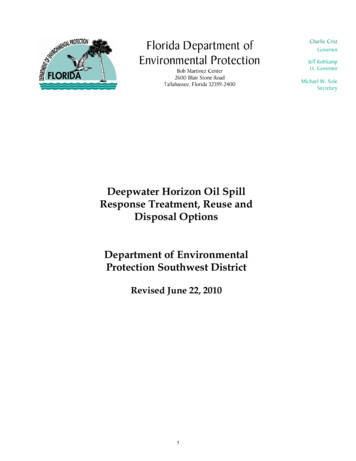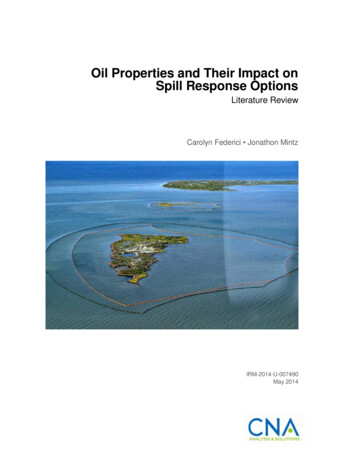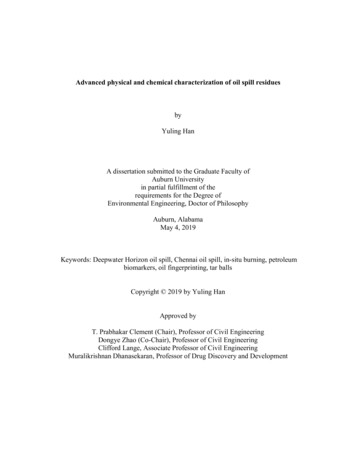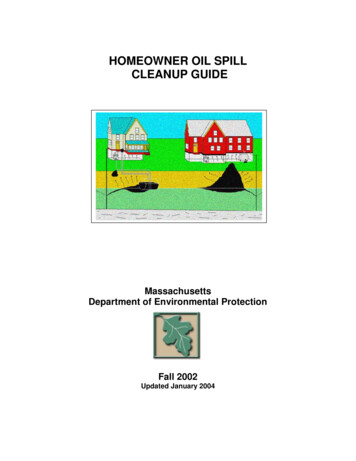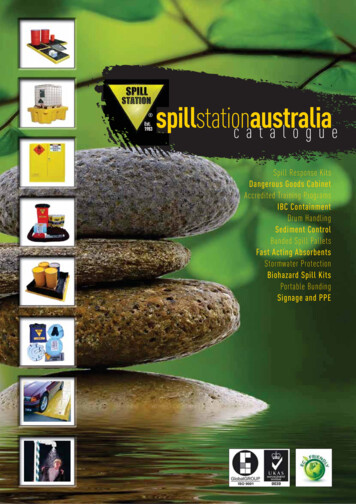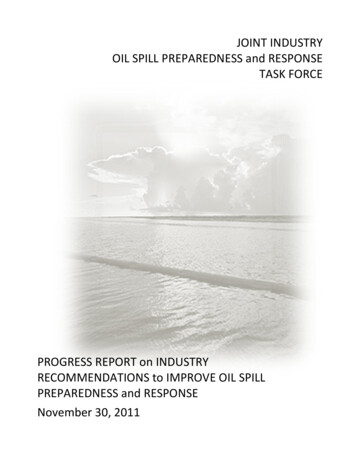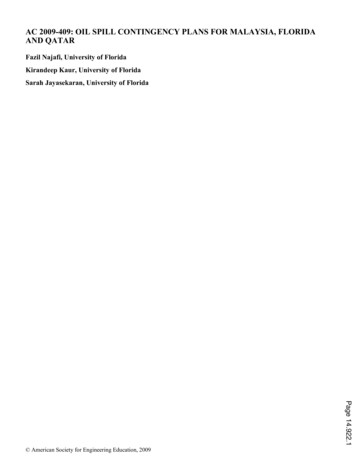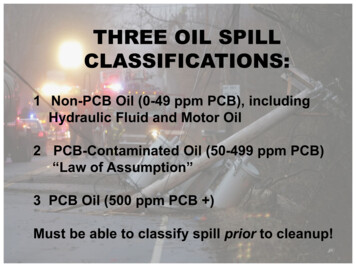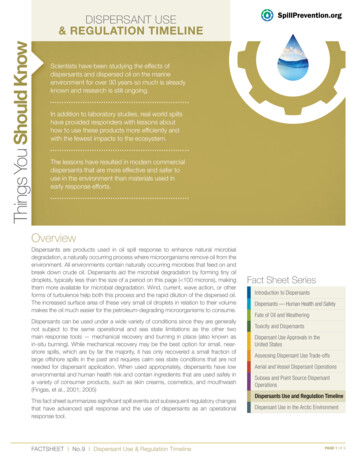
Transcription
Things You Should KnowDISPERSANT USE& REGULATION TIMELINEScientists have been studying the effects ofdispersants and dispersed oil on the marineenvironment for over 30 years so much is alreadyknown and research is still ongoing.In addition to laboratory studies, real world spillshave provided responders with lessons abouthow to use these products more efficiently andwith the fewest impacts to the ecosystem.The lessons have resulted in modern commercialdispersants that are more effective and safer touse in the environment than materials used inearly response efforts.OverviewDispersants are products used in oil spill response to enhance natural microbialdegradation, a naturally occurring process where microorganisms remove oil from theenvironment. All environments contain naturally occurring microbes that feed on andbreak down crude oil. Dispersants aid the microbial degradation by forming tiny oildroplets, typically less than the size of a period on this page ( 100 microns), makingthem more available for microbial degradation. Wind, current, wave action, or otherforms of turbulence help both this process and the rapid dilution of the dispersed oil.The increased surface area of these very small oil droplets in relation to their volumemakes the oil much easier for the petroleum-degrading microorganisms to consume.Dispersants can be used under a wide variety of conditions since they are generallynot subject to the same operational and sea state limitations as the other twomain response tools — mechanical recovery and burning in place (also known asin-situ burning). While mechanical recovery may be the best option for small, nearshore spills, which are by far the majority, it has only recovered a small fraction oflarge offshore spills in the past and requires calm sea state conditions that are notneeded for dispersant application. When used appropriately, dispersants have lowenvironmental and human health risk and contain ingredients that are used safely ina variety of consumer products, such as skin creams, cosmetics, and mouthwash(Fingas, et al., 2001; 2005)This fact sheet summarizes significant spill events and subsequent regulatory changesthat have advanced spill response and the use of dispersants as an operationalresponse tool.FACTSHEET I No.9 I Dispersant Use & Regulation TimelineFact Sheet SeriesIntroduction to DispersantsDispersants — Human Health and SafetyFate of Oil and WeatheringToxicity and DispersantsDispersant Use Approvals in theUnited StatesAssessing Dispersant Use Trade-offsAerial and Vessel Dispersant OperationsSubsea and Point Source DispersantOperationsDispersants Use and Regulation TimelineDispersant Use in the Arctic EnvironmentPAGE 1 OF 9
DISPERSANT USE & REGULATION TIMELINEIntroductionOn 18 March 1967, the tanker vessel (T/V) Torrey Canyon ranaground on Pollard’s Rock near Cornwall, England carryingnearly 860,000 barrels (36,120,000 gallons; 137,000 m3) ofcrude oil. Much of the oil was consumed in a fire or lost intothe Atlantic Ocean. The spill response in 1967 was the firsttime responders realized that mechanical recovery methodswere not going to be effective for the incident because of theweather and wave conditions in the spill area. As a result,they attempted to chemically remove the oil from the watersurface and shoreline and mix the oil into the water columnusing chemical degreasers that were not designed for oil spillresponse to “disperse” the oil. This was an unfortunate initialattempt to “disperse” oil as these degreasers are generallycited as doing more harm than good.From these beginnings, the world response communityhas learned many lessons and now utilizes very differentlow toxicity dispersant formulations. Dispersants are a keycomponent of the spill response tool kit, and in many casesand countries they represent a primary or secondary responseoption. In all cases, dispersant products and their use areregulated by government agencies to ensure that they areused appropriately and effectively.Figure 1(a-e) displays a timeline from 1967 to 2010 thatsummarizes the history of significant spill response eventswith dispersant use and the subsequent regulatory actions. Itshould be noted that the list is a sampling of events and doesnot include the evaluation of dispersant performance duringnumerous large scale test tank and field trial evaluations. Aslessons have been learned and regulatory requirements havebeen developed, modern dispersants have been preparedthat are effective under a range of conditions and when usedappropriately, have low environmental and human health risk.The decision to use or not use dispersants in response to aspill should be based on a well informed Net EnvrionmentalBenefit Analysis (NEBA) (see Fact Sheet 6: AssessingDispersant Use Trade-offs).1967 — T/V Torrey Canyon, Cornwall, England, UKAt the time, the T/V Torrey Canyon was the biggest onwater oil spill in world history — losing nearly 470,000 barrels(19.7 million gallons; 75,000 m3) of crude oil over a 12 dayperiod. Little was known about how to deal with a spill of thissize. Ultimately, more than 120 miles (190 km) of coastlinewere affected by the oil with extensive damage to marineand intertidal communities. The spill created an oil slickmeasuring 270 square miles (700 km2), and oiled 180 milesFACTSHEET I No.9 I Dispersant Use & Regulation Timeline(300 km) of coastland. More than 15,000sea birds and large numbers of aquaticanimals were estimated to be killed beforethe spill was brought under control.Unfortunately, efforts to clean up the oilonly compounded the situation when theRoyal Navy attempted to disperse it usingindustrial degreasers.These products were toxic, resulting in agreat deal of damage to the marine environment, birds, sealions, and other marine life. The use of these degreasers isgenerally considered to have been a great mistake.1968 — Initial US National Contingency PlanThe US responded to the Torrey Canyon spill by developingits first National Contingency Plan (NCP). It was thenation’s initial attempt to develop a coordinated approachto cope with potential spills in U.S. waters and providedthe first comprehensive system of accident reporting, spillcontainment, and cleanup.1969 — Well A-21 Blowout — Santa Barbara, CA, USAOn 28 January 1969 the Santa Barbara,1969 Santa Barbara wellCA well (A-21), located six miles off theblowout. Photo: from the LATimes onlinecoast, experienced a blowout and oilbegan to leak. Several unsuccessfulattempts were made to cap the leak.An estimated 77,000 barrels (3.2 milliongallons; 12, 000 m3) of oil were released,causing significant damage to shorelinesand injuring thousands of birds and marinemammals. As part of the response, 900barrels (37,500 gallons; 143 m3) of theproduct, ARA Gold Crew Bilge Cleaner,were applied to the slick in an attempt to mix the oil into thewater column to prevent shoreline impacts. As with the TorreyCanyon response, this product was not created for dispersingoil. No official estimates of effectiveness or toxicity were madefor the cleaning product (Fingas 2011; NOAA, 1992).The 1969 Santa Barbara Well A-21 response was the first useof dispersants during an ocean blowout.1970 — Water Quality Improvement Act andNCP AuthorizedRecognizing the importance of clean water to the publichealth and welfare, the US Congress legislated the basiclegal authority for federal regulation to improve the qualityPAGE 2 OF 9
DISPERSANT USE & REGULATION TIMELINEFIGURE 1(A).Timeline of dispersant use and subsequent regulatory changes: 1967 – 1970U.S. initiates firstNCP to developa coordinatedapproach forpotential spills inU.S. WatersTorrey Canyon,Cornwall, England(nearshore)19671968Well A-21 blowout,Santa Barbara, CAUSA (nearshore)1969of water resources and to establish a national policy forthe prevention, control, and abatement of water pollution.Additional legislation was passed that expanded its authorityover water quality standards and water polluters through theWater Quality Improvement Act of 1970. This Act placedadditional limits on the discharge of oil into water where itcould damage human health, marine life, wildlife, or property.The act also included a number of other provisions intendedto reduce water pollution.Congress also broadened the scope of the NCP to includea framework for responding to hazardous substance spillsas well as oil discharges. Over the years, additional revisionshave been made to the NCP to address further legislationrelated to oil spills.1970 — US Environmental Protection AgencyEstablishedOn 2 December 1970, President Nixon established the USEnvironmental Protection Agency (EPA) to consolidate federalresearch, monitoring, standard-setting, and enforcementactivities into one agency to ensure environmental protectionof US waters.Due to the haphazard nature of water quality regulation,Congress restructured the authority for water pollution controland consolidated authority in the EPA Administrator.1970 — Chevron Main Pass Block 41, Platform C, Gulfof Mexico (GOM), USAOn 10 February — 10 March 1970, the Chevron Main PassBlock 41C platform burned as oil and gas were lost fromthe wellhead. An estimated 65,000 bbls (2.7 million gallons;FACTSHEET I No.9 I Dispersant Use & Regulation TimelineWater QualityImprovement Actauthorized; resultedin the developmentof the NationalContingency Plan1970Establishment of theU.S. EnvironmentalProtection Agency197010,300 m3) of crude oil were released into the environment.Once the fire was out, approximately 2,000 bbls (84,000gallons; 320 m3) of dispersants were applied to the platform toprevent the rig from re-igniting; no attempt was made to treatthe entire slick with dispersants. Little damage was recordedfor beaches, wildlife, or marine life from the spill and dispersedoil. The application of dispersants in this manner was from ahealth and safety standpoint, rather than as an operationalresponse tool (NOAA, 1992).1972 — US Clean Water Act AuthorizationThe Federal Water Pollution Control Act of 1948 was thefirst major US law to address water pollution. As amended in1972, the law became commonly known as the Clean WaterAct (CWA). The amendment (from EPA online, 2012): “Established the basic structure for regulating pollutantsdischarges into the waters of the US. Gave EPA the authority to implement pollution controlprograms such as setting wastewater standards forindustry. Maintained existing requirements to set water qualitystandards for all contaminants in surface waters. Made it unlawful for any person to discharge any pollutantfrom a point source into navigable waters, unless a permitwas obtained under its provisions. Funded the construction of sewage treatment plantsunder the construction grants program. Recognized the need for planning to address the criticalproblems posed by nonpoint source pollution.”PAGE 3 OF 9
DISPERSANT USE & REGULATION TIMELINEFIGURE 1(B).Timeline of dispersant use and subsequent regulatory changes: 1970 – 1979Chevron Main PassBlock 41, Platform C(offshore); 2,000bbls of dispersantapplied — consideredeffective1970Establishment of theClean Water Act of1972. Extensive legislationin U.S.; made provisionsfor post spill reporting,response, & liability byresponsible party1972International MaritimeOrganization (IMO)adopted the MARPOL19731973 — International Maritime Organization AdoptsInternational Convention for the Prevention ofPollution from Ships (MARPOL)The IMO adopted the International Convention for thePrevention of Pollution from Ships (MARPOL) on 2 November1973, which covered pollution by ships from operational oraccidental causes. This included pollution from oil, chemicals,harmful substances in packaged form, sewage, and garbage.Subsequent modification of the 1973 Convention hasincorporated tanker design and operations into the Protocol(IMO online, 2013).1978 — T/V Eleni V, Southeast coast of Norfolk,England, UKOn 6 May 1978, the T/V Eleni V collided with another vesseland was broken in two off the southeast coast of England.Approximately 52,500 bbls (2.2 million gallons; 8,400 m3)of heavy fuel oil was released. The oil was very thick andproduced a large “viscous slick that was brown to black incolor” (NOAA, 1992) and impacted both the UK and Dutchcoastlines with thick emulsions washing ashore. Respondersapplied some 6,800 bbls (285,000 gallons; 1,100 m3) ofdispersants over a three week period to the spreading slicks.However, due to the oil type, weathering, and emulsification,the products available at the time were not effective and didlittle to prevent shoreline oiling. This response confirmed thatthe dispersant formulations that existed at the time were noteffective on heavy viscous oils (NRC, 1989).1979 — Ixtoc-1 Well Blowout, GOM, MexicoOn 3 June 1979 the Ixtoc I platform, located in Mexico’sBay of Campeche located in the southern Gulf of Mexico,FACTSHEET I No.9 I Dispersant Use & Regulation TimelineEleni V, collision offSE Coast of England(offshore); 6,800bbls dispersantapplied; Consideredineffective due tohigh viscosity oil1978experienced a blowout due toa loss of drilling mud circulation.The oil and gas being releasedat the surface caught fire andthe platform collapsed into thewellhead area, preventing initialattempts to control the release.lxtoc I well blowout,Bay of Campeche,Mexico (offshore)1979IXTOC-1 well blowout. Photo: NOAA.The well was estimated toproduce 20,000 barrels per day [bpd] (840,000 gallons perday; 3,200 m3 per day). When it was capped on 23 March1980, the total discharge was estimated to be 3,520,000bbls (148 million gallons; 562,000 m3) (Fingas, 2011; NOAA,1992). As part of the response, approximately 1,100 squaremiles (2900 km2) of surface slicks in Mexico’s waters weretreated with the dispersant Corexit 9527 which was designedspecifically for use with on-water oil spills. While quantitativemeasurements of dispersant effectiveness do not exist for themultiple applications to a range of different slicks, there wereindications that the use of dispersants did reduce the amountof surface oil (Fingas, 2011; NOAA, 1992; NRC, 1989).1984 — T/V The Puerto Rican, San Francisco, CA, USAThe T/V Puerto Rican response was the first time thatdispersants were authorized on a major oil spill in the US.The ship broke into two parts following explosions and firesapproximately 32 miles (51 km) offshore from the Golden GateBridge, San Francisco, CA. Approximately 100,000 barrels(4,200,000 gallons; 16,000 m3) of lube oil, bunker fuel, andadditives were discharged into the Pacific Ocean. The spillwas treated with 50 barrels (2,000 gallons; 7.6 m3) of Corexit9527 and was considered initially effective (NOAA, 1992;NRC, 1989).PAGE 4 OF 9
DISPERSANT USE & REGULATION TIMELINEFIGURE 1(C).Timeline of dispersant use and subsequent regulatory changes: 1984 – 1990T/V Puerto Rican,explosion 25 mileswest of San Francisco,CA (offshore); 2,000gallons dispersantapplied — consideredeffective1984T/V Exxon Valdez(nearshore)application ofdispersant —effective buttoo lateM/V Pacbaroness,Point Conception,CA USA198719891987 — M/V Pacbaroness, Point Conception, CA, USAAfter a collision with another vessel,the bulk carrier Pacbaroness sankin almost 1,400 feet (425 m) ofwater almost twelve miles (19 km)off the coast of Point Conception,CA, discharging over 30 bpd(1,200 gallons per day; 4.6 m3 perday) of fuel oil. It is thought that upto 475 bbl (20,000 gallons; 760 m3) of fuel oil may have beenreleased from the wreckage.Pacbaroness. Photo: NOAA.This spill provided an opportunity to study the effectivenessof oil dispersants. Three separate dispersant trials wereconducted by applying more than 8 barrels (350 gallons; 1.3m3) of Corexit 9527 using fixed wing aircraft and helicopterapplications. Even with careful measurements, the resultsof the study were somewhat inconclusive because ofcomplicating factors, such as slick breakup due to heavywinds, the thin nature of the slick and the limited area oftreatment (NOAA, 1992).1989 — T/V Exxon Valdez, Prince William Sound,AK, USAExxon Valdez incident in Prince WilliamSound, AK. Photo: NOAA.The 24 March 1989 grounding ofthe tanker Exxon Valdez on Blighreef created the US’s secondlargest on water spill response,with more than 262,000 bbls(10,900,000 gallons; 41,000m3) of crude oil released into aremote, scenic, and biologicallyproductive body of water. Thetype of oil that was released,FACTSHEET I No.9 I Dispersant Use & Regulation TimelineM/V Mega Borg(offshore); firstoperational useof ADDS packfor dispersantapplication —considered effectiveOil Pollution Act of1990 — designed torefine/enhance U.S.spill prevention andresponse capabilities19901990Alaska North Slope or ANS, has been studied on numerousoccasions since and has been found to be amenable todispersion. An initial aerial dispersant application trial wasthought to be successful, but severe weather during the earlystages of the spill response halted any further dispersantapplications and dispersants were not a tool that was usedduring the response (Wiens, 2013)This incident prompted the US to revise its oil spill prevention,response, and cleanup preparedness regulations.1990 — The Oil Pollution Act of 1990The US Congress passed the Oil Pollution Act (OPA) in August1990, following the Exxon Valdez incident.“The OPA improved the nation’s ability to prevent and respondto oil spills by establishing provisions that expand the federalgovernment’s ability, and provide the money and resourcesnecessary, to respond to oil spills. The OPA also createdthe national Oil Spill Liability Trust Fund, which is available toprovide up to one billion dollars per spill incident.In addition, the OPA provided new requirements forcontingency planning both by government and industry.The National Oil and Hazardous Substances PollutionContingency Plan (NCP) has been expanded in a three-tieredapproach: the Federal government is required to direct allpublic and private response efforts for certain types of spillevents; Area Committees — composed of federal, state, andlocal government officials — must develop detailed, locationspecific Area Contingency Plans; and owners or operators ofvessels and certain facilities that pose a serious threat to theenvironment must prepare their own Facility Response Plans.Finally, the OPA increased penalties for regulatorynoncompliance, broadened the response and enforcementPAGE 5 OF 9
DISPERSANT USE & REGULATION TIMELINEFIGURE 1(D).Timeline of dispersant use and subsequent regulatory changes: 1993 – 2000International Conventionon Oil PollutionPreparedness &Response (OPRC) —global framework forinternational cooperationfor major incidentsM/V Broer (nearshore);130 tons dispersantapplied during calmweather — consideredeffective199319951996authorities of the Federal government, and preserved Stateauthority to establish law governing oil spill prevention andresponse.” (excerpted from USEPA online, 2011)1990 — T/V Mega Borg, GOM, USAOn 8 June 1990, the Mega Borgwas disabled by a fire and explosionin the Gulf of Mexico, 57 miles (92km) southeast of Galveston, TX ininternational waters. The ship thendrifted while leaking burning oil forseveral days before the fire wasextinguished. Estimates indicatethat between 300-1,000 barrels(12,000-40,000 gallons; 45–150 m3) of light crude oil werereleased into the water and did not burn. The use of Corexit 9527 was authorized within five nautical miles (9 km) of thestricken vessel to treat the rapidly spreading surface oil.Six dispersant applications over a five-day period totaling 300 barrels (11,300 gallons; 43 m3) were determined to beeffective on the crude oil surface slicks (NOAA, 1992).T/V Mega Borg incident in the USGOM. Photo: NOAA.1993 — M/V Braer, Shetland, Scotland, UKThe Braer foundering off Shetland,Scotland. Photo: www.thetimes.co.uk.On 5 January 1993 the M/V Braerran aground very close to shore atGarth’s Ness, Shetland, Scotlandduring heavy weather. Over a12 day peroid nearly all of its600,000 barrel (25 million gallons;95,000 m3) cargo of NorwegianGullfaks crude oil and its heavybunker oil were released as the shipbroke apart. Conditions preventedFACTSHEET I No.9 I Dispersant Use & Regulation TimelineT/V Red Seagull(offshore); 100gallons of dispersantapplied- first useof fire monitor forapplication —effectiveT/V Sea Empress(estuary); 444 tonsof dispersant appliedfirst long-term datacollection efforts —partially effective1998Poseidon pipelinebreak (offshore);6,000 gallonsdispersant appliedover 3 days;considered effective2000mechanical recovery, but during calmer periods 1,000 bbl(42,000 gallons; 130 m3) of dispersant (Dasic) was applied.The M/V Braer was unusual because no large surface slickwas produced and cleanup was minimal for the volumespilled, primarily because of the very energetic conditions ofthe wind and waves. The oil was effectively dispersed bothnaturally and by the addition of dispersants. This incidentdemonstrated that dispersion can prevent effects associatedwith a floating slick (Kingston, 1999).1995 — International Convention on Oil PollutionPreparedness, Response, and Co-Operation (OPRC)OPRC is the first overarching international agreement dealingwith response to marine pollution. It was adopted by IMO inNovember 1990 and became international law in May 1995.The Convention is designed to: Help governments prepare for and respond to major oilpollution incidents Facilitate international co-operation and mutual assistancerelative to a major oil pollution incident Encourage States to develop and maintain an adequatecapability to deal with oil pollution emergencies.1996 — M/V Sea Empress, Milford Haven, Wales, UKOn 15 February 1996, the M/V Sea Empress, carrying roughly460,000 bbl (19.5 million gallons; 74,000 m3) of forties crudeoil and 2,300 bbl (100,000 gallons; 370 m3) of heavy fuel oilran aground and released its cargo. This incident was thefirst to be monitored promptly and in detail. Methods usedincluded two aircraft equipped with Side Looking AirborneRadar (SLAR), downward looking video, as well as Infrared (IR)PAGE 6 OF 9
DISPERSANT USE & REGULATION TIMELINEFIGURE 1(E).Timeline of dispersant use and subsequent regulatory changes: 2004 – 2010Main Pass 69Pipeline spill(nearshore); 350gallons dispersant;first nearshoredispersant applicationand night time use2004USCG Caps Regulation— establishedequipment capabilitiesrequirements ondispersant use for vesseland facility plan holders2009West Atlas (Montara)well blowout (offshore);43,000 gallonsdispersant, (aerialand vessel) primaryresponse method —considered effective2009Deepwater Horizon(Macando 252) well blowout(offshore); 1.8 million gallonsdispersant applied at seasurface and first use of pointsource (subesea injection) —considered effective2010MMS reorganization(BOEM, BSEE) in thewake of DeepwaterHorizon response tobetter address offshoreenergy development2010and UV cameras. Modeling wasalso used to assist in planning.Approximatley 2,800 bbl (120,000gallons; 444 m3) of Corexit andDasic dispersants were appliedand research indicated that asignificant amount of emulsifiedoil formation was prevented.This likely served to preventoiling of wildlife and commerciallyimportant beaches and served to demonstrate the potentialthat dispersant use offers (White and Baker, 1998).Over a two-day period, approximately 140 bbl (6,000 gallons;23 m3) of Corexit 9527 dispersant was applied to the surfaceslicks. An estimated 75% effectiveness rate was observedfor the first day of applications. Using the required analyticalprotocols, on-water dispersant monitoring efforts verifiedthat the dispersant application had been effective. Oncethe dispersant appeared to lose its effectiveness as the oilweathered (for more information, see Fact Sheet 3: Fate ofOil and Weathering), dispersant operations were halted. Thisdispersant application was considered to be highly successfuland documented by both visual observation and analyticalmethods based on fluorometry measurements (Henry, 2005).1998 — M/T Red Seagull tanker, Galveston, TX, USA2004 — Main Pass 69 Pipeline, Louisiana, USAThe M/T Red Seagull began leaking light crude oil while anchoredin the Galveston Lightering Area and released a total of 400 bbl( 17,000 gallons; 64 m3) of oil. After the leak was repaired it wasestimated that 100 bbl (4,200 gallons; 16 m3) of oil were trappedunder the ship. As a response measure and also a demonstrationof the ability of fire monitors to be used for application ofdispersants, an estimated 20-30 bbl (840-1,260 gallons; 3-5m3) of oil were effectively treated with 80 gallons Corexit 9500.This application demonstrated the proof of concept for using amodified fire monitor to apply dispersant. Additionally, effectivedispersion of the surface oil was reported. (Henry, 2005).On 15 September 2004, Hurricane Ivan damaged the MainPass 69 pipeline where an 18 inch (0.46 m) and a 20 inch (0.51m) pipeline crossed; both lines were damaged and leakedcrude oil. The leak continued for 20 days until the source wascontrolled. An estimated 7,000 bbl (300,000 gallons; 1,140m3) of oil may have been released.M/V Sea Empress vessel casualty.Photo: www.walesonline.co.uk.2000 — Poseidon Pipeline Discharge, GOM, USAOn 21 January 2000, a 24” (0.61 m) crude oil pipeline thattransports oil from offshore to onshore facilities experienceda pipeline failure and leak approximately 65 miles (105 km)south of Houma, Louisiana. The spilled oil was within a preapproval zone for dispersant use and met all US EPA RegionalResponse Team requirements for authorization.FACTSHEET I No.9 I Dispersant Use & Regulation TimelineDue to the location of the release site, the US Fish & WildlifeService noted that approximately 2,000 birds on an exposedsandbar were at immediate risk from the oil and thousands ofother birds were potentially at risk in the general area. Given thatthe spill location was outside the existing pre-authorization zone,specific approval was required to proceed with dispersant use.This was granted and dispersants were applied in areas whereoil escaped the recovery operations and presented a direct riskto wildlife and sensitive habitat. A total 8 bbl (350 gallons; 1.3 m3)of Corexit 9527 and 120 bbl (5,000 gallons; 19 m3) of Corexit9500 were applied on two different days. While dispersanteffectiveness received mixed reports, this represented the firsttime dispersants were applied in nearshore waters since OPA 90was enacted (Henry, 2005).PAGE 7 OF 9
DISPERSANT USE & REGULATION TIMELINE2009 — US Coast Guard CAPS RegulationThe USCG initiated the “CAPS” rule (Vessel and Facility ResponsePlans for Oil: 2003 Removal Equipment Requirements andAlternative Technology Revisions) in 2009, making dispersantcapability a regulatory requirement for vessels and facilitiesplanning in the US by 2011. The CAPS rule enhances theexisting response requirements by requiring advance contractsfor dispersants and related delivery equipment; and, aerialtracking and trained observation personnel.2009 — Montara Well Blowout, East Timor Sea, AustraliaOn 1 August 2009 the Montarawellhead platform off of thenorthwestern Australia in the EastTimor Sea had a blowout, releasingoil and gaseous hydrocarbons intothe environment. The dischargecontinued for 10 weeks until thewell was killed on 3 November andcapped by 3 December, 105 daysafter the initial blowout. The incident response was challengedsince the platform was located 140 nautical miles (260 km)from shore.The Montara Wellhead Platformcasualty. Photo: AMSA.Initial estimates were that the well was releasing approximately400 bbl (17,000 gallons of oil; 65 m3) per day, but laterestimates ranged from 400 to 3,000 bbl (17,000 to 126,000gallons; 65 to 4,800 m3) per day. Over the duration of theincident, the majority of the oil remained within 19 nauticalmiles (35 km) of the platform (AMSA, 2010).Aerial dispersant operations began on August 23rd andcontinued through November 1st. Seven types of dispersantswere applied during this period — approximately 1,160 bbl(48,600 gallons; 184 m3) — using aerial and vessel sprayingoperations. It was eventually concluded that in this response,the use of dispersants “was highly effective in assisting thenatural process of biodegradation and minimising the risk ofoil impacts on reefs or shorelines” (AMSA, 2010).2010 — Deepwater Horizon Blowout, GOM, USAestimate is 2.45 million barrels(102.9 million gallons; 389,500 m3)(Post-Trial Memorandum, 2013).The Deepwater Horizon Platform onfire. Photo: USCG.Numerous response techniqueswere used, including the applicationof 43,000 barrels (1.8 million gallons;6800 m3) of dispersant. Approximately18,000 barrels (770,000 gallons;2,900 m3) of which were appliedthrough subsurface injection at the source of the leak at theseafloor (National Commission, 2011; Lehr et al., 2010). Foradditional information on the use of dispersants in a subseaapplication, see Fact Sheet 8 — Subsea and Point SourceDispersant Operations.This spill response continues to be the most studied in UShistory. The use of dispersants is considered to have beeneffective in the water column for enhanced biodegradation(Camilli et al., 2010; Hazen et al., 2010); however the fullenvironmental effects continue to be studied. Numerousresearch projects are studying long-term and short-termeffects of the oil, dispersant, and the dispersant-oil mixture.Studies range from overall environmental effects, to individualspecies DNA level effects.2010 — Minerals Management Service (MMS)ReorganizationThe Minerals Management Service was created on 19 January1982, consolidating components from the U.S. GeologicalSurvey, the Bureau of Land Management and the Bureau ofIndian Affairs. In the wake of the Deepwater Horizon response,the President of the US tasked the Secretary of the Departmentof the Interior to conduct a fundamental restructuring of MMSto divide its three conflicting missions into separate entities withindependent missions. The new divisions include: Bure
use in the environment than materials used in early response efforts. . water oil spill in world history — losing nearly 470,000 barrels 3) of crude oil over a 12 day period. Little was known about how to deal with a spill of this . spill containment, and cleanup. 1969 — Well A-21 Blowout — Santa Barbara, CA, USA
